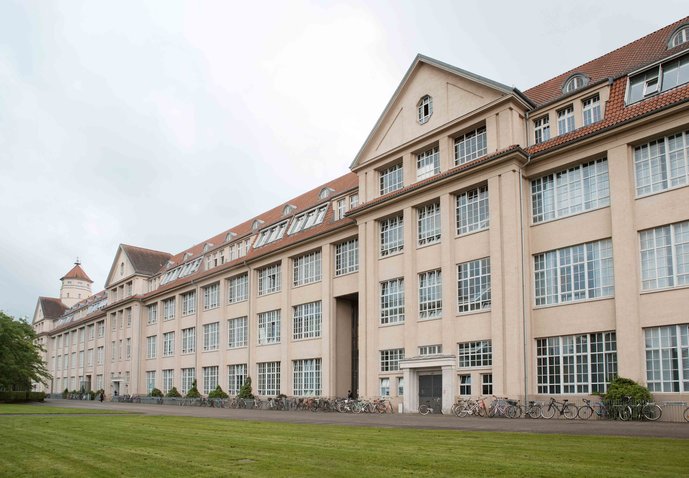Presentation of the podcast MUNITIONSFABRIK 28.04.2022, 6.30 pm, atrium 3
This spring, the Karlsruhe University of Arts and Design celebrates its 30th birthday. The university's literature seminar has taken this occasion to take a closer look at the history of the building, which today stands for the close connection between art, media and innovative teaching.
In the last century, armaments were produced in the listed hall building, which were used millions of times during the Second World War. For the production of weapons and ammunition, thousands of forced laborers were used in Karlsruhe starting in 1941. They were housed in more than 40 camps in the city and often did not survive. Even into the 1970s, the building complex, which the university shares with the ZKM, the Städtische Galerie and the Kunsthalle Karlsruhe, was used to coordinate the production of disk mines, which were manufactured in Grötzingen and marketed worldwide.
To get this dark chapter of the HfG's university history talking, students in the literature seminar led by Prof. Dr. Stephan Krass have compiled an extensive collection of material and produced a five-part podcast from voices, documents, and historical sources, which is now being presented at a public event. Guests on the podcast include filmmaker Sebastian Drost, architectural historian Dr. Kerstin Renz, and city archivist Jürgen Schuhladen-Krämer. Moderators are students Mo Frank and Lennart Polach. Thomas Fröhlich, Chancellor of the HfG Karlsruhe, will welcome the public event.
Diesen Beitrag Teilen auf
{"/en/aktuelles/": {"style": "aktuelles", "label": "News", "children": {"container_attrs": "data-ng-cloak data-hfg-news-filter", "style": "blackout", "/en/aktuelles/": {"style": "news", "label": "All"}, "/en/aktuelles/ausstellung": {"style": "exhibition", "label": "Exhibition"}, "/en/aktuelles/projekt": {"style": "project", "label": "Project"}, "/en/aktuelles/veranstaltung": {"style": "event", "label": "Event"}, "/en/aktuelles/kooperation": {"style": "cooperation", "label": "Cooperation"}, "/en/aktuelles/meldung": {"style": "announcement", "label": "Announcement"}, "/en/aktuelles/offene-stellen": {"style": "job-vacancies", "label": "Job vacancies"}, "/en/aktuelles/aktuelle-publikationen": {"style": "new-publications", "label": "New publications"}}}, "/en/hochschule/": {"label": "About us", "children": {"/en/hochschule/mission/": {"label": "Mission statement", "hidden": "true"}, "/en/hochschule/geschichte/": {"label": "History"}, "/en/hochschule/lehre/": {"label": "Teaching"}, "/en/hochschule/organe-und-gremien/": {"label": "Boards and committees", "children": {"/en/hochschule/organe-und-gremien/rektorat/": {"label": "Rectorate"}, "/en/hochschule/organe-und-gremien/senat/": {"label": "Senate"}, "/en/hochschule/organe-und-gremien/hochschulrat/": {"label": "University Council"}, "/en/hochschule/organe-und-gremien/gleichstellungsbeauftragte/": {"label": "Gender Equality Representative"}, "/en/hochschule/organe-und-gremien/behindertenbeauftragter/": {"label": "Representative for the Disabled"}, "/en/hochschule/organe-und-gremien/personalrat/": {"label": "Staff Council"}, "/en/hochschule/organe-und-gremien/asta/": {"label": "Students\u2019 Union"}, "/en/hochschule/organe-und-gremien/fachgruppensprecherinnen/": {"label": "Department Spokespersons"}}}, "/en/hochschule/verwaltung/": {"label": "Administration"}, "/en/hochschule/bekanntmachungen-des-rektorats/": {"label": "Announcements from the rectorate"}, "/en/hochschule/kooperationen/": {"label": "Cooperations"}, "/en/hochschule/zentrale-einrichtungen/": {"label": "Central facilities", "children": {"/en/hochschule/zentrale-einrichtungen/bibliothek": {"label": "Library"}, "/en/hochschule/zentrale-einrichtungen/studios-und-werkstaetten": {"label": "Studios and workshops"}, "/en/hochschule/zentrale-einrichtungen/ausleihe": {"label": "Loans"}}}, "/en/hochschule/foerdergesellschaft/": {"label": "Development fund"}, "/en/hochschule/presse-oeffentlichkeitsarbeit/": {"label": "Press / Public relations"}, "/en/hochschule/publikationen/": {"label": "Publications", "children": {"/en/hochschule/publikationen/jahresberichte/": {"label": "Annual Reports"}, "/en/hochschule/publikationen/informationsbroschueren/": {"label": "Information brochures"}, "/en/hochschule/publikationen/munitionsfabrik/": {"label": "Munitionsfabrik"}, "/en/hochschule/publikationen/edition-76135/": {"label": "Edition 76135"}, "/en/hochschule/publikationen/neue-folge/": {"label": "Neue Folge"}, "/en/hochschule/publikationen/reihe-hfg-forschung/": {"label": "Reihe HfG Forschung"}, "/en/hochschule/publikationen/massnahme/": {"label": "Ma\u00dfnahme"}, "/en/hochschule/publikationen/schriftenreihe-der-hfg-bei-cantz/": {"label": "cantz book series"}, "/en/hochschule/publikationen/weitere-publikationen/": {"label": "Various publications"}}}, "/en/hochschule/downloads/": {"label": "Downloads"}, "/en/hochschule/informationen-fuer-hochschulangehoerige/": {"label": "Information for University Staff and Students"}, "/en/hochschule/stellen/": {"label": "Job vacancies"}}}, "/en/studium/": {"label": "Studies", "children": {"/en/studium/fachgruppen-und-studiengange/": {"label": "Departments and courses of study", "children": {"/en/studium/fachgruppen-und-studiengange/ausstellungsdesign-und-szenografie/": {"label": "Exhibition Design and Scenography"}, "/en/studium/fachgruppen-und-studiengange/kommunikationsdesign/": {"label": "Communication Design"}, "/en/studium/fachgruppen-und-studiengange/produktdesign/": {"label": "Product Design"}, "/en/studium/fachgruppen-und-studiengange/kunstwissenschaft-und-medienphilosophie/": {"label": "Art Research and Media Philosophy"}, "/en/studium/fachgruppen-und-studiengange/medienkunst/": {"label": "Media Art"}}}, "/en/studium/studieninteressierte/": {"label": "Prospective Students"}, "/en/studium/bewerbung/": {"label": "Application", "children": {"/en/studium/bewerbung/studienberatung-und-mappenberatung/": {"label": "Study and portfolio advice"}, "/en/studium/bewerbung/bewerbungsverfahren/": {"label": "Application procedure"}, "/en/studium/bewerbung/zulassung-und-eignungspruefung/": {"label": "Admission requirements and aptitude examination"}, "/en/studium/bewerbung/immatrikulation/": {"label": "Enrollment"}, "/en/studium/bewerbung/gasthoererinnen/": {"label": "Auditors", "children": {"/studium/bewerbung/gasthoererinnen/gasthoererinnen/": {"label": "Auditors"}, "/studium/bewerbung/gasthoererinnen/hoererinnen-vom-kit/": {"label": "Auditors from KIT"}}}, "/en/studium/bewerbung/informationen-fuer-internationale-bewerberinnen/": {"label": "Information for international applicants"}}}, "/en/studium/preise-und-stipendien/": {"label": "Prizes and Scholarships"}, "/en/studium/wohnen-und-leben-in-karlsruhe/": {"label": "Living in Karlsruhe"}, "/en/studium/downloads/": {"label": "Downloads"}, "/en/studium/kontakt/": {"label": "Contact"}}}, "/en/vorlesungsverzeichnis/": {"label": "University Calendar"}, "/en/forschung-und-entwicklung/": {"label": "Research and Development", "children": {"/en/forschung-und-entwicklung/forschungsfoerderung/": {"label": "Research Funding"}, "/en/forschung-und-entwicklung/forschungsprojekte/": {"label": "Research Projects"}, "/en/forschung-und-entwicklung/promovieren/": {"label": "Doctorates"}, "/en/forschung-und-entwicklung/promotionsprojekte/": {"label": "Doctoral Projects"}, "/forschung-und-entwicklung/orc/": {"label": "Open Resource Center", "children": {"/forschung-und-entwicklung/orc/auda/": {"label": "AuDA"}}}}}, "/en/international/": {"label": "International", "children": {"/en/international/incomings": {"label": "Incomings", "children": {"/en/international/incomings/informationen-fuer-internationale-bewerberinnen/": {"label": "Information for international applicants"}, "/en/international/incomings/erasmus/": {"label": "Exchange Students (Erasmus+/Overseas)"}, "/en/international/incomings/praktische-informationen-fuer-internationale-studierende/": {"label": "Practical information for international students"}, "/en/international/incomings/freemover/": {"label": "Free Movers"}}}, "/en/international/outgoings/": {"label": "Outgoings", "children": {"/en/international/outgoings/wege-ins-ausland/": {"label": "Going abroad"}, "/en/international/outgoings/foerdermoeglichkeiten/": {"label": "Funding opportunities", "children": {"/en/international/outgoings/foerdermoeglichkeiten/erasmus/": {"label": "Erasmus+"}, "/en/international/outgoings/foerdermoeglichkeiten/promos/": {"label": "PROMOS"}, "/en/international/outgoings/foerdermoeglichkeiten/baden-wuerttemberg-stipendium/": {"label": "Baden-W\u00fcrttemberg Scholarship"}, "/en/international/outgoings/foerdermoeglichkeiten/freemover/": {"label": "Free movers"}}}, "/en/international/outgoings/partnerhochschulen/": {"label": "Partner universities", "children": {"/en/international/outgoings/partnerhochschulen/erasmus-partnerhochschulen/": {"label": "Erasmus partner universities"}, "/en/international/outgoings/partnerhochschulen/internationale-austauschprogramme/": {"label": "International exchange programs"}}}, "/en/international/outgoings/erfahrungsberichte": {"label": "Student Experiences"}}}, "/en/international/dokumente/": {"label": "Documents"}, "/en/international/strategie/": {"label": "Strategy"}}}, "/en/kontakt/": {"label": "Contact"}, "/en/service/": {"label": "Service", "children": {"/en/service/allgemeines/": {"label": "General Information"}, "/en/service/health-and-safety/": {"label": "Health and Safety"}, "/en/service/studieninteressierte/": {"label": "Prospective Students"}, "/en/service/studierende/": {"label": "Students"}, "/en/service/beschaeftigte/": {"label": "Employees"}, "/en/service/partner-und-alumni/": {"label": "Partners and Alumni"}}}, "/en/personen/": {"label": "People"}, "/en/suche/": {"label": "Search"}, "/en/studierenden-projekte/": {"label": "Student projects"}, "https://zkm.de/en": {"label": "ZKM"}, "/en/aktuelles/corona/": {"label": "Corona measures"}}

